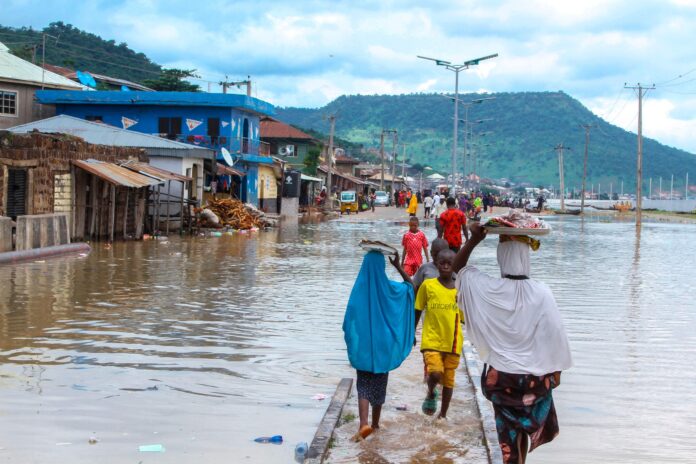By Eberechi Obinagwam
At least 603 people lost their lives to flood last year.
The deaths were partly due to the negligence of the government to heed early warning risk disaster reports.
Federal Government data report shows that the flood of 2022 displaced over 1.4 million people, injured more than 2,400 persons, damaged about 82,035 houses, and affected about 332,327 hectares of land.
A warning ignored
NEMA had warned that the 2022 flood disaster would be worse than that of 2012 when at least 363 people were killed and over 2.1 million people were displaced by floods, with an estimated $16.9 billion of the country’s total losses.
NIHSA Director-General, Clement Nze, last year, while featuring on a Channels TV programme, said states that were affected by the flood were adequately and timely warned about the impending crisis but they failed to take action.
He blamed state and local governments for disregarding “adequate and timely warnings” and weather advisories issued by various agencies such as the Nigeria Hydrological Services (NIHSA) and the Nigerian Meteorological Agency (NiMet) to avert flood disaster in 2022.
The flooding was caused by heavy rainfall and climate change as well as the release of water from the Lagdo Dam in neighbouring Cameroon, which began on 13 September.
On September 13, 2022, Eneo Cameroon (the Cameroonian electricity company) released a statement to inform residents of Garoua (a port city and the capital of the North Region of Cameroon, lying on the Benue River) and its environs that the dam will release between September and October 2022, urging them to steer clear of hazardous and flood-prone zones within the period. But, the Nigerian government did nothing or little about it.
The great negligence
Many years ago, the Cameroon and Nigerian authorities brainstormed on the chances of possible flooding and agreed that both countries should construct dams to cushion the effect.

The Nigerian government agreed to build its own dam (the Dasin Hausa Dam) in Adamawa while the Cameroonian government agreed to build the Lagdo Dam.
The Cameroonian government built Lagdo Dam within five years (between 1977 and 1982). That is 41 years ago. The Dasin Hausa Dam is yet to be finished.
The economic, and social cost
International Center for Investigative Reporting (ICIR), in its recent publications, said investment worth about N700 billion in Nigeria’s agricultural sector was destroyed by the 2022 flood.
According to ICIR, the data was contained in the latest report by the National Agricultural Extension Research Liaison Services (NAESRLS).
Executive Director of NAESRLS, Emmanuel Ikani, in the report, said, the release of water from the Lagdo dam in Cameroon was the main cause of the flood in South-South, South-East and North-Central regions of the country while flooding in the North-West, North-East and South-West was due to heavy rainfall and blockage of existing drainages.
He noted that Kebbi, Delta, and Cross River States with calculated index values of 0.3500, 0.2951 and 0.2218 respectively were the most severely affected by the 2022 flood while Nasarawa, FCT and Oyo with 0.0515, 0.0243 and 0.0079, respectively were the least affected.
Ikani, said, last year’s floods damaged crops and destroyed agricultural land, leading to reduced yields and economic losses for farmers.
He said it is estimated that there are over 3000 gully erosion sites in the 10 most-affected States in the South-East, South-South, and South-West regions of Nigeria.
Flooding and the Climate Change Connection
Rainfall and climate change are causes of floods.
A shift in temperatures and weather patterns, which can be natural due to changes in the sun’s activity or large volcanic eruptions, is how climate change contributes to floods.
According to actionaid.org.uk, Climate change has increased the frequency and intensity of floods and other natural weather-related events that we are witnessing around the world.
2023 flood alert
Again, NEMA through its director general, Mustapha Ahmed, has warned of massive flooding in 2023, calling for action to be taken early enough to avert any disasters.
The DG, according to The Cable said Nigeria will experience severe flooding in 2023 as indicated by predictions from responsible agencies.

Ahmed spoke at an experts’ technical training on climate disaster preparedness held in Abuja.
He said the seasonal climate predictions and annual flood outlook released by the Nigerian Meteorological Agency (NiMet) and the Nigeria Hydrological Services Agency (NIHSA), should be acted upon.
He said the flood disaster in 2022 was a wake-up call for emergency responders, adding that the agency would spread early warning messages to states and LGAs, and the federal capital territory (FCT).
Ahmed in the report said the team of experts assembled by the agency will come up with comprehensive early warning messages in order to build a prepared and resilient public and safeguard lives and livelihoods.
Also, Clement Nze, director-general of NIHSA, said that 178 LGAs in 32 states and the FCT had been predicted to experience severe flooding in 2023.
State of preparations
To mitigate the effects of floods disasters in Nigeria, the National Emergency Management Agency, (NEMA) and the United Nations Disaster Risk Reduction, have developed a program in partnership with the Nigerian Meteorological Agency (NIMET) and Nigerian Hydrological Service (NIHSA) to downscale early warning alerts to communities.
Director General of NEMA, Mustapha Habib-Ahmed in the report, said downscaling early warnings will ensure that communities are protected from flood disasters as earlier predicted by the Nigerian Meteorological Agency (NIMET).
In a statement by the Public Relations Officer (PRO), NEMA, Manzo Ezekiel, the DG explained that the partnership has brought about the setting up of the recent 2023 Climate-Related Preparedness and Mitigation Strategies on flood predictions.

He said other key partners expected to drive the strategy include the Nigerian Hydrological Service (NIHSA).
At a United Nations bilateral meeting in New York, Habib-Ahmed who presented Nigeria’s statement on the Mid-term review of the Sendai Framework for Disaster Risk Reduction (SFDRR) 2015-2030, noted that with the hindsight of the 2022 flood disaster experience, “the Federal Government of Nigeria has also set up a Presidential Committee for the development of a comprehensive Plan of Action for Preventing Flood Disaster in Nigeria.
“The inclusive approach adopted was in tandem with the intent of the UN Secretary-General, Antonio Guterres initiative in 2022 which declared the UN spearhead of new actions to ensure that every person on earth is protected from floods using early warning systems within the next five years.
“NEMA in collaboration with the Nigerian National Space Development Agency (NASDA) is working assiduously to increase the availability of, and access to multi-hazard early warning systems and disaster risk information in an inclusive manner through both conventional and non-conventional communications channels including the social media,” he said.
He explained further that to actualize priorities and targets, NEMA is currently organizing national and sub-national platforms across Nigerian states and the Federal Capital Territory (FCT).
According to him, “This constitutes an important integral part of achieving progress in the country’s drive towards sub-national level implementation of the UNDRR protocols.
“NEMA in partnership with UNDP under the Sahel Resilience Project has held a series of workshops on the establishment of a National Disaster Database and Risk-informed development in Nigeria with the main objective of addressing current and future risk and promoting disaster and climate risk-informed decisions, investment and development.”
In furtherance to this, Google recently announced the expansion of its Flood Hub platform to cover 80 countries worldwide, including the addition of 8 new countries in Africa, Nigeria included.
This expansion comes as part of AI-enabled efforts to address the devastating impacts of floods and provide critical support to vulnerable communities.
The Flood Hub platform offers forecasts up to 7 days in advance, benefitting a population of 460 million people globally.
To further enhance flood preparedness, Google is expanding flood alerts through Search and Maps notifications, ensuring that individuals have convenient access to timely and critical flood information. This expansion aims to empower more people to take necessary precautions and safeguard lives and property.
Floods can be curtailed by properly discarding refuse and avoiding throwing waste into moving water because it will block water drainage.
Trees should be planted to absorb water and dykes built around rivers to help obstruct the flow of river water into lowlands.
Also, dams should be built to help store excess water from flooding zones.













